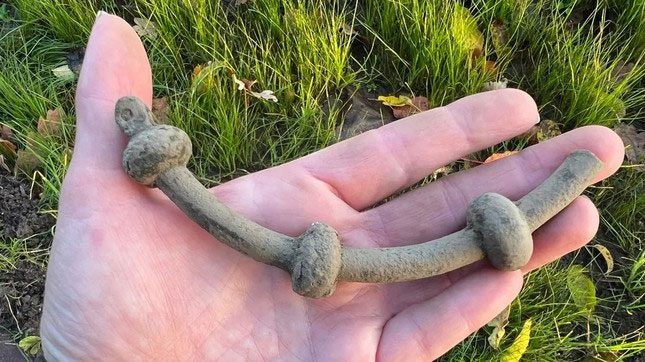Archaeologists in Denmark have discovered a weapons cache consisting of over 100 spears and javelins buried beneath the home of an Iron Age chieftain. This 1,500-year-old collection is substantial enough to equip a small army and may have served as a “sacrificial offering.”

A piece of the bronze bracelet – a symbol of power during the Iron Age discovered in the archaeological excavation in Denmark. (Photo: Vejle Museum)
Between the 1st and 4th centuries AD, Denmark was on the fringes of the Roman Empire, part of the vast region known as Germania. Most of the people in this area were ordinary farmers, but Romans like Julius Caesar wrote about fierce Germanic warriors. Some scholars suggest that the Romans may have supplied weapons to tribes in Denmark, possibly to maintain peace along the border with Scandinavia.
The archaeologists found this treasure during a highway expansion project in August at a site known as Løsning Søndermark in Denmark. The metal weapons were located beneath two 5th-century houses, likely belonging to a figure powerful enough to raise an army. Since the weapons were intentionally buried, researchers believe they may have been offered as a tribute after a victory. The treasure includes metal objects comprising 119 spears and javelins, eight swords, five knives, an axe, and a rare set of iron armor.
Very few pieces of Iron Age armor have been found in southern Scandinavia, and the Løsning armor is the first to be discovered from a settlement site rather than a burial site. This exquisite armor took considerable time to produce, so according to archaeologists, it might have belonged to the chieftain himself.
In addition to the weapons, archaeologists also found fragments of two bronze necklaces known as “oath rings.” These accessories were symbols of power during the Iron Age, further attesting to the chieftain’s influence. The research team also uncovered pieces of horse harness and a brass horn, along with several iron and bronze objects.
Although this weapons cache is linked to the home of an Iron Age chieftain, archaeologists are still uncertain whether these items belonged to local warriors or were accumulated as war spoils.


















































